EA Survey 2018 Series: Community Demographics & Characteristics
Summary
The EA survey provides an annual snapshot of the EA community. Although it does not sample randomly from all effective altruists, it does provide an important glimpse at demographic attributes among those who have taken the survey. From these respondents, we observe that the majority of effective altruists look demographically much like those in past years. After cleaning the data and limiting the data set to those who declared that they self-identified as effective altruists, we sampled a total of 2,607 valid respondents for this report. In total, we surveyed 3,537 people. More people took the effective altruist survey than ever before, and this additional data enables us to look at the demographics of the effective altruism movement in more depth. In this report, we also aim to explore the characteristics and tendencies of EAs, including diets, political beliefs, careers, and relationships.
Insights
Age
The majority of the respondents that took the survey are people aged 20-29, at 50.13% of the respondents. The ages of the respondents cluster in the categories of 20-29 and 30-39, with a long tail of older respondents. The youngest respondent that gave their age was aged 14 and the oldest was 81. The mean age of the respondents sampled was 31, which is slightly older than last year’s mean age of 29. In 2017, the median age was 27, while this year the median age was 28. The increase in age is likely driven by survey respondents who are already in the effective altruism movement aging, rather than older people joining effective altruism.
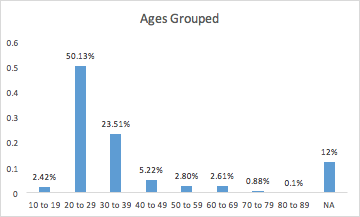
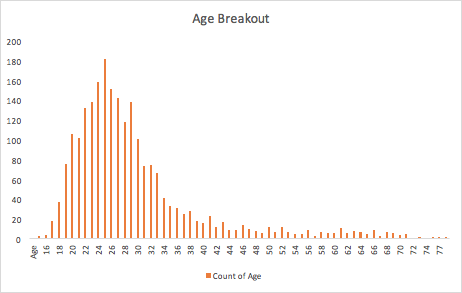
Gender
The majority of people who took the survey reported being male (67%), while 29% of respondents reported that they were female, and approximately 4% described themselves as other or declined to self-identify. This is closely aligned with the 2017 survey, which had the following gender breakdown: “70.1% identified as male, 26.01% identified as female, 1.9% respondents identified as “other”, and another 21 respondents preferred not to answer.”
Education
Effective altruists report being highly educated, with roughly 83% having a post high school degree. The majority of respondents hold a bachelor's degree (38%), followed by master’s degrees (27%), then doctoral degrees (13%).
The following chart shows the numbers of respondents within each education level breakout.
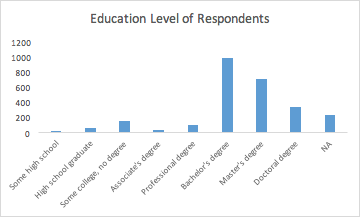
Subject of Study
The majority of the effective altruists surveyed reported being highly educated at a rate higher than that of the United States. The subjects that EAs have chosen to focus on vary. In order of descending popularity, the most chosen subjects of study were: computer science, math, and philosophy. A majority of effective altruists reported studying subjects considered to be STEM. This question was a multi-select, so respondents had the opportunity to select multiple different categories of studies.
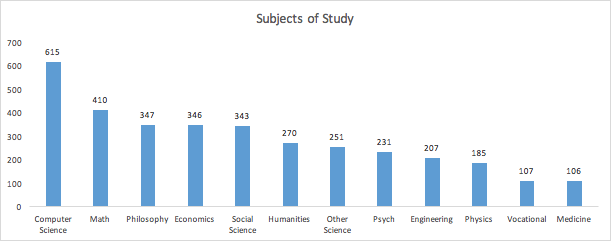
Careers
Most effective altruists are employed full-time (43%), followed by people who are full-time students (27%). Of the effective altruists who took the survey and answered the employment question, very few (5%) reported that they are unemployed and looking for work. This question was asked as a multi select, so these were not mutually exclusive.
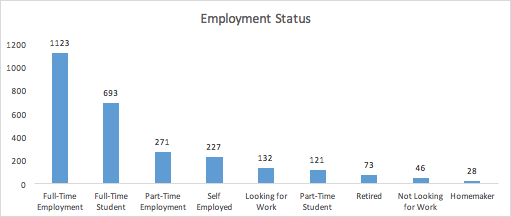
Field of Employment
The fields that effective altruists are employed in are wide-ranging. Most people selected the “Other (please specify)” option (14%). The top three career paths that people are currently following include: tech, education, and nonprofits. While this year we worked to be more inclusive of different fields of work for respondents to select, it’s clear we can improve by adding more options in the next survey.

Location
Country
The majority of respondents reported being located in the United States (36%), followed by the UK (16%), Germany (7%), and Australia (6%). In total, there were responses from 74 different nations and 21 nations had 10 or more responses.
Cities
The question in the 2018 survey asking respondents where they live was developed from the list of the top 30 cities respondents most reported living in the 2017 survey. There was also the opportunity for respondents put in their own city/town within the answer option of “Other (please specify)”. The answers to the city/town question showed a remarkable diversity of location across the globe. Cities not listed on the survey as options were selected by 42% of respondents. The most commonly reported location was the San Francisco Bay Area (with 9% of respondents) followed by London (7%) and NYC (4%).
SF Bay Area
234
Seattle
38
Canberra
22
Osnabrück
8
London
178
Cambridge (UK)
35
Philadelphia
22
Vienna
8
New York City
96
Los Angeles
31
Oslo
16
Baltimore
7
Boston / Cambridge (USA)
67
Chicago
30
Prague
16
Bristol
6
Berlin
59
Toronto
28
Madison
14
Other (please specify)
1092
Melbourne
59
Vancouver
26
Munich
13
Oxford
56
Zurich
26
Montreal
11
Washington, DC
45
Stockholm
25
Trondheim
10
City Distribution
The following chart shows the number of respondents within each city. “Other (please specify)” is not broken out within this chart.
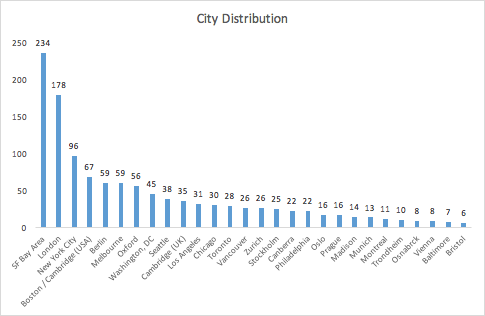

Race/Ethnicity
Of the respondents who answered the ethnicity question (which allowed for multiple selection), the majority of responses were from people who self-identified as “white” (78%). While fewer respondents selected white than last year (in 2017, 89% of respondents identified as white), there wasn’t any marked increase in other ethnicities represented due to the large percentage of people who preferred not to say or opted out of the question.
Ethnicity
White
78.29%
Asian
7.33%
Hispanic
2.84%
Black
0.84%
Native American
0.35%
Pacific Islander
0.31%
Religious Affiliation
Roughly the same proportion of people identified as “atheist, agnostic, or non-religious” this year (80%) compared to 2017 (80%). Slightly more people identified as Buddhist this year (3.34%) compared to last year’s 1.9%, but overall the religious affiliations of effective altruists who took the survey are fairly stable.
Religion
Count
Atheist, agnostic, or non-religious
1883
Christian
209
Other
88
Buddhist
79
Prefer Not to Answer
54
Jewish
41
Muslim
7
Hindu
4
Diet
Diets of effective altruists vary, as is evidenced by the chart below. Those who eat meat and those that abstain from eating meat are present in roughly equal amounts. Compared to traditional American diets, effective altruists over-index on being vegetarian/vegan by 10x. 39% of the effective altruism population reported being vegan or vegetarian. The distribution of responses regarding dietary decisions varies according to gender, with 18% of male respondents reporting they eat meat (and not reporting an attempt to reduce their meat consumption), compared with 7% of female respondents. More women reported being vegan and pescetarian than men. Men and women reported being “reducetarian” in roughly equal amounts (~29%).
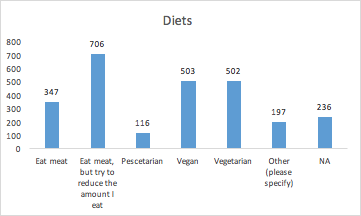
As diets are a personal and complex part of our lives, it was clear from the “Other (please specify)” responses that there is an even wider variety of diets that were not included in our list in 2018. This may warrant an expansion of choices in future years, such as “lacto-vegetarian.”
Political Beliefs
Our political beliefs question was somewhat limited, as it did not capture the probable variation of respondents political beliefs with respect to geography. The majority of respondents (61%) reported identifying with the “left” politically. In future reports, we may dive further into what these political orientations look like when viewed through the lens of geography.
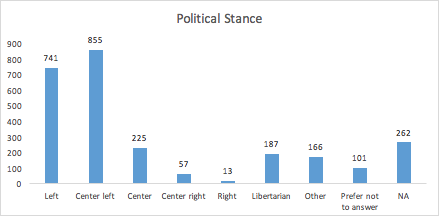
Relationship Status
In exploring the relationship statuses of effective altruists, a survey design oversight may have skewed the data. Our question was flawed in that it did not allow for people who were both “polyamorous” as well as “married” to select the appropriate status. We also did not include an “Other (please specify)” option as we did in other questions for people to share what they felt was relevant to their lives. In analyzing this question, we can consider it to be more of a general overview of how people felt that their relationships were best represented within in the confines of the offered choice set. Overall, roughly half (51%) of effective altruists reported being in some form of relationship and 36% of EAs reported that they were single at the time of this survey.
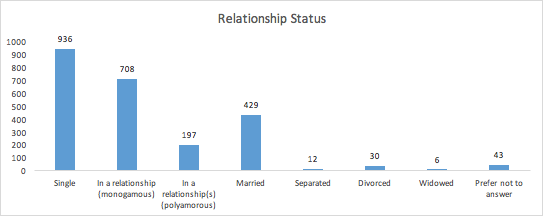
Recap
Overall, the demographic makeup of the effective altruism movement has not significantly shifted in the last year of sampling. Effective altruists are typically white males in their mid 20’s according to this survey. As our sampling instrument is biased towards respondents with access to the internet and who are subscribers to media outlets associated with effective altruism, the actual distribution of demographics is likely different than the one we shared above. Still, it is critical to utilize the tools that we have access to in order to assess even a rough snapshot of the attributes and health of a community.
While this data on its own is more descriptive, it helps to set the stage when it comes to subjects such as cause preference or donation data. By better understanding demographic diversity and behavioral trends within the EA community, we can make more informed assessments of why cause preferences may shift over time, or why degree of engagement with different organizations may change within the EA community.
Credits
This post was written by Lauren Whetstone.
A special thanks to Peter Hurford and David Moss for contributing analysis. Thanks to Tee Barnett, Sophie Winter, and Hannah Wilbourne for editing.
We would also like to express our appreciation to the Centre for Effective Altruism, Scott Alexander of Slate Star Codex, 80,000 Hours, EA London, and Animal Charity Evaluators for their assistance in distributing the survey. Thanks also to everyone who took and shared the survey.
The annual EA Survey is a project of Rethink Charity with analysis and commentary from researchers at Rethink Priorities.
Supporting Documents
Other Articles in the 2018 EA Survey Series
II - Distribution & Analysis Methodology
III - How do people get involved in EA?
IV - Subscribers and Identifiers
VIII- Where People First Hear About EA and Higher Levels of Involvement
IX- Geographic Differences in EA
X- Welcomingness- How Welcoming is EA?
XI- How Long Do EAs Stay in EA?
XII- Do EA Survey Takers Keep Their GWWC Pledge?
Prior EA Surveys conducted by Rethink Charity
- The 2017 Survey of Effective Altruists
- The 2015 Survey of Effective Altruists: Results and Analysis
- The 2014 Survey of Effective Altruists: Results and Analysis
Raw Data
Anonymized raw data for the entire 2018 EA Survey can be found here.

Nice work! Very interesting!
33 people said Sydney which ranks us at #11 (between Cambridge and Los Angeles)... do we get a radio button next time ;)
Give this man a radio button!
Noted for next year! :)
Alas another year goes by and Sydney doesn't make the cut despite hosting another EAGx 😜
That adds up to more than 100%. I am confused.
Edit - Incorrect guess.
My guess is it was meant to say 1.3%, and that not prefer wasn't included.
Looking at this year the figure is 1.9%, and I'm assuming the second figure for prefer not to answer is meant to be 2.1% not 21 people.
Apologies! We had a data error here and included the incorrect percentages from rebasing. I've corrected the chart and data in the report
"Most people selected the “Other (please specify)” option (14%)." --> "The single most common answer was “Other (please specify)” (14%)." :)
Similarly, the word "majority" is used in a couple places where it should have instead said "plurality." (Sorry to be nitpicky)
Appreciate the feedback!
I think it might be clearer to break up the Bay Area into SF, East Bay, North Bay and South Bay. These locations all take about an hour to travel between, which makes them comparable to London, Oxford and Cambridge (even Bristol). Including such a large area as a single category makes it much easier to rank top. Wikipedia reports that London is about 600 square miles, while the nine-county Bay Area is 7000. I appreciate that what counts as a city is not clear, but I'd definitely say the Bay Area is more than one city. (Alternatively, we could group 'Loxbridge' as one category.)
Seems plausible that it'd be worth making this change although it does seem complicated.
A lot of people commute from the East Bay into SF. It's not clear to me whether somebody who lives in Oakland/Berkeley but works in SF should be included as 'SF' or 'East Bay.' Am I right that this is a lot less common in Loxbridge? If so, that makes the communities feel somewhat more distinct.
I don't know England well enough to figure out where each city's suburbs end but when I made a vague attempt to draw an area around Loxbridge, it seemed to be about 5,000 square miles. That's actually pretty close to the area of the Bay Area, which is 3,000 square miles if you just include the four counties where (I think) the overwhelming majority of EAs live: Alameda, San Mateo, Santa Clara, and San Francisco. (You don't have to travel through the other five counties to travel between these ones).
Minor: I'd say the travel times in 'Loxbridge' are somewhat longer than an hour.
Time from (e.g.) Oxford train station to London train station is an hour, but adding on the travel time from 'somewhere in Oxford/London to the train station' would push this up to ~2 hours. Oxford to Cambridge takes 3-4 hours by public transport.
The general topic looks tricky. I'd guess if you did a kernel density map over the bay, you'd get a (reasonably) even gradient over the 3k square miles. If you did the same over 'Loxbridge' you'd get very strong foci over the areas that correspond to London/Oxford/Cambridge. I'd also guess you'd get reasonable traffic between subareas in the bay area, but in Loxbridge you'd have some Oxford/London and Cambridge/London (a lot of professionals make this sort of commute daily) but very little Oxford/Cambridge traffic.
What criteria one uses to chunk large connurbations into natural language looks necessarily imprecise. I'd guess if you had the ground truth and ran typical clustering algos on it, you'd probably get a 'bay area' cluster though. What might be more satisfying is establishing whether the bay acts like a single community: if instead there is a distinguishable (e.g.) East Bay and South Bay community, where people in one or the other group tend to go to (e.g.) events in one or the other and visit the other occasionally (akin to how an Oxford-EA like me may mostly attend Oxford events but occasionally visit London ones), this would justify splitting it up.
Obviously these results (and last year's) spark a concern about diversity. Has the EA community made any attempts to analyze, understand, and seek to remedy the causes behind the lack of gender and racial diversity based on the results of these surveys?
While most communities grow within a defined demographic at first, advocacy and community-building is a main goal and tenet of effective altruism. I'm concerned that numbers this skewed have a negative effect on this goal, and would love to know if the community has sought to understand and address this yet.
One example of trying to understand the reasons is the London group's collecting and analyzing attendance data, with the conclusion that men and women initially come in equal numbers but women are less likely to return:
http://effective-altruism.com/ea/1rt/are_men_more_likely_to_attend_ea_london_events/
More thoughts and posts in the "Diversity & Inclusion in EA" group:
https://www.facebook.com/groups/diversityEA/
Thanks!
The link to the raw data doesn't work for me and links to https://github.com/peterhurford/ea-data/blob/master/data/2018/2018-ea-survey-anon-currencied-processed.csv%20for%202018 Enter https://github.com/peterhurford/ea-data/blob/master/data/2018/2018-ea-survey-anon-currencied-processed.csv instead and I believe you end up where you should end up.
We've fixed the data link so it should be working now. Apologies for the inconvenience!
Neither the link in the text nor Chi's links work for me. They both give 404. I can't find the data when looking directly at Peter's github either https://github.com/peterhurford/ea-data/tree/master/data/2018
The raw data is temporarily offline right now. We'll hopefully get it back up in the next few days.
Having stumbled here via the blog posts from the 2017 survey's donation statistics, I have a request for the upcoming 2018 donation statistics: would it be possible to make a diagram and/or table showing the distribution of donations by their amount?
To clarify, I would be interested in answering questions like: "What percentage of the total amount donated in [year] were made through individual annual donations above 100$? Above 500$? Above 1,000$?" ... and so on.
Graphically, this could take the form of a cumulative donation curve, with the % of the total amount donated on the y-axis and the individual donation amounts on the x-axis, sorted from smallest to largest (left to right).
Depending on how it turned out, this could (charitably interpreted):
(a) provide "smaller" donors with encouragement about how important all of their individual contributions are, despite their apparent individual insignificance, or
(b) provide the EA community with confirmation of just how much impact a tiny number of individual large donors can have, any why it's so important to continue to actively enlist their financial support.
I was inspired to comment by looking into the two most recent AMF financial reports (https://www.againstmalaria.com/FinancialInformation.aspx) and discovering that despite the highest ~4 donations being 15.1 million $, and 3 times ~ 1 million $, the remainder of the donations still made up 45 to 65% of the total donations. But then I wanted to know what the distribution below 1 million $ looked like, since e.g. 500,000$ is still quite a large amount of money that very few people are able to donate.
I'd be happy to take the lead on this using Excel, once the link to the data is restored. In case this could in your view lead to undesirable unintended consequences, how and whether to display this information at all could still be discussed and decided by you guys.
Thanks so much for all your efforts!
Thanks for the feedback Tom, this would be awesome to dig into! We'll let you know once the data is restored.
Sounds great, thanks!
No question about moral philosophy?
The link to the raw data at the end of the post is dead. I would like to have the raw data of EA surveys, especially recent ones -- is there a way to get them?
Who are the altruists in Baltimore? I’m a naive do-gooder who gave away a kidney, turned apartments into homeless shelters and give away almost all my money. I’m studying to be a nurse and trying to raise money fo Partners In Health.
I’m hoping to find like-minded people to give advice, or encouragement, or ideas. Maybe this is the wrong place to ask to meet someone but I’ve never met anyone who thinks like me, and it damages so many relationships to refuse to spend money on a movie outing or meal—people seem to need those to be social. How do people live compatible with others?
Super late response, but it's hella cool that you're doing all that!
EA Johns Hopkins looks inactive based on its Facebook page, unfortunately. It doesn't look like there's a general EA Baltimore meetup group either. Still, there are always online places like Discord and Reddit.
It can be frustrating that social activities often revolve around spending money, especially if your friends aren't accommodating about your frugality. There might be Meetup groups in your area about doing things for cheap, or you can suggest some free events to your friends. Overall though, I think that if you can afford it, it might be worthwhile spending a bit of money to hang out with your friends, if that's something you'd enjoy – it should help with your mental health, and investing in relationships could plausibly boost your earnings enough to compensate for what you're spending.
Do you have much data on the ~900 (2/7 of responses) that were invalid and what those reasons are?
We've now written a bit more about that here: https://forum.effectivealtruism.org/posts/K2u4rvy38YmSnhQ5X/ea-survey-series-2018-subscribers-and-identifiers
We should have a post coming out soon about that.